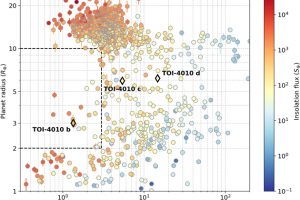A rich and complex planetary system for the star TOI-4010. The paper: “TOI-4010: A System of Three Large Short-period Planets with a Massive Long-period Companion” of M. Kunimoto (MIT) appeared on AJ)

To date (November 2023), we have confirmed the presence of 5539 exoplanets in 4128 planetary systems. These numbers indicate that, in the majority of cases, we have identified one planet per planetary system. This limitation is primarily due to observational constraints, as it remains challenging to detect small exoplanets with long orbital periods (distant from their stars several astronomical units, where 1 AU equals 150 million km, representing the average distance between Earth and the Sun).
However, there are noteworthy exceptions to this. One of the most known multiple exoplanetary systems is orbiting around the star Trappist-1, hosting six rocky planets, including three situated within the habitable zone (which is the region around a star where rocky planets may maintain temperatures suitable for liquid water on their surfaces). Another star hosting multiple planets is TOI-4010, a star with a mass of 0.8 solar masses and high metallicity (indicating an elevated abundance of chemical elements heavier than helium and hydrogen), which hosts three planets.
The figure (click here to visualize the image entirely) shows the period-radius diagram of known planets, with marked the “neptunian desert” and the position of TOI-4010 b, c, and d.
Mario Giuseppe Guarcello ( follow mariospiegacose) ( mariospiegacose) ( follow mariospiegacose)
Follow the Astronomical Observatory of Palermo on Facebok and on Instagram
Subscribe the Youtube channel of the Astronomical Observatory of Palermo
